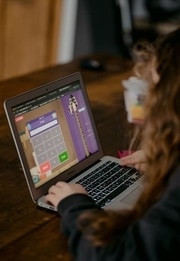Screen Time: Ensuring a Positive Experience for Children Online
In 2021, increased screen time was ranked as one of the top three negative effects of the Covid-19 pandemic. During this time, the screen time of teenagers more than doubled from the 2019 numbers, increasing from 3.8 hours per day to 7.7 hours per day the following year, not including screen time necessary for activities like schoolwork or listening to music.
Studies also show that a shocking 50% of teens claim to feel addicted to their phones, and an alarming 72% feel the need to immediately check notifications and messages that they may receive.
Social Media and Screen Usage
This increase in social media and screen usage has led to further detrimental experiences among teenagers in the realm of mental health and bullying. It has been reported that adolescents who use social media more than 3 hours per day are at a heightened risk of mental health issues and other negative side effects such as self-esteem issues, diminished body image, or feelings of isolation and loneliness, or even cyberbullying.
For younger children, medical health experts also advise on special restrictions for toddlers ages 18-24 months, and another set of rules for children ages 2-5.
Unregulated Content
Another significant issue with younger people beginning to use social media more often is the accidental exposure to inappropriate content that is unregulated on the internet. On average, children are first exposed to pornography at age 11, while in general, 34% of internet users have experienced unwanted exposure to this type of content while online.
This early exposure can be harmful, as it normalizes unsafe behavior and possible violence, as well as opens the door to the dangerous world of child pornography and sexual abuse. In a shocking 77% increase in just one year, one third of reported child sexual abuse material was self-generated, with 80% of that content coming from 11 to 13 year old girls.
Online Safety for Children
Most parents are worried about their child’s safety online, and support the initiative to create an online environment that is more safe for them and their families. 40% of accidental exposure to inappropriate sexual content online was found by innocently entering simple search phrases into unregulated search engines.
In addition, many young children are exposed to violence prematurely through video games or video content meant for adults. It is not difficult to bypass age verification systems on websites and games, and many of these activities require communication with strangers who are often much older than the child playing.
Guidelines and Limits
Establishing ground rules, good digital habits, enabling parental controls, and keeping an open line of communication with the child are all effective strategies to ensure that minors have a safe and positive experience when using the internet.
Read how parenting styles influence playtime activities offline to help reduce screen time play.
It has been found that the majority of young teens feel more comfortable when their parents use control software to keep them safe online. As the internet and social media continue to develop, there are many options and strategies for families to ensure that their children are having nothing but positive experiences online.
Check out this Infographic of what unlimited screen time can do to kids:

It’s never too early to teach internet safety. Children of every age need to be guided and given boundaries online, including even the youngest family members. Review this internet safety checklist for preschoolers.




 Katie Brenneman is a passionate writer specializing in education, mental health, family lifestyle and online safety. When she isn’t writing, you can find her with her nose buried in a book or hiking with her dog, Charlie. You can follow her on
Katie Brenneman is a passionate writer specializing in education, mental health, family lifestyle and online safety. When she isn’t writing, you can find her with her nose buried in a book or hiking with her dog, Charlie. You can follow her on 


